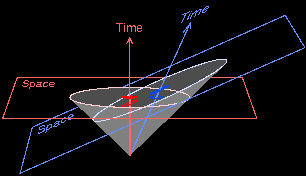Lorentz gamma factor
 How much slower does Cerulean's clock run, from Vermilion's point of view?
In special relativity the factor is called
\(\gamma\)
the
Lorentz gamma factor,
introduced by the Dutch physicist
Hendrik A. Lorentz in 1904,
one year before Einstein proposed his theory of special relativity.
Let us see how the Lorentz gamma factor
\(\gamma\)
is related to Cerulean's velocity \(v\).
In units where the speed of light is one, \(c = 1\),
Vermilion's mirror is one tick away from her,
and from her point of view the vertical distance between Cerulean
and his mirror is the same, one tick.
But Vermilion thinks that the distance travelled by the light beam
between Cerulean and his mirror is
\(\gamma\)
ticks.
Cerulean is moving at speed \(v\),
so Vermilion thinks he moves a distance of
\(\gamma v\)
ticks during the
\(\gamma\)
ticks of time taken by the light to travel from Cerulean to his mirror.
Thus, from Vermilion's point of view,
the vertical line from Cerulean to his mirror,
Cerulean's light beam,
and Cerulean's path form a triangle with sides
\(1\),
\(\gamma\)
and
\(\gamma v\)
as illustrated.
Pythogoras' theorem implies that
\[
1^2 + ( \gamma v )^2 = \gamma^2
\]
from which it follows that
the Lorentz gamma factor
\(\gamma\)
is related to Cerulean's velocity \(v\) by
\[
\gamma = {1 \over \sqrt{1 - v^2}}
\]
which is Lorentz's famous formula.
How much slower does Cerulean's clock run, from Vermilion's point of view?
In special relativity the factor is called
\(\gamma\)
the
Lorentz gamma factor,
introduced by the Dutch physicist
Hendrik A. Lorentz in 1904,
one year before Einstein proposed his theory of special relativity.
Let us see how the Lorentz gamma factor
\(\gamma\)
is related to Cerulean's velocity \(v\).
In units where the speed of light is one, \(c = 1\),
Vermilion's mirror is one tick away from her,
and from her point of view the vertical distance between Cerulean
and his mirror is the same, one tick.
But Vermilion thinks that the distance travelled by the light beam
between Cerulean and his mirror is
\(\gamma\)
ticks.
Cerulean is moving at speed \(v\),
so Vermilion thinks he moves a distance of
\(\gamma v\)
ticks during the
\(\gamma\)
ticks of time taken by the light to travel from Cerulean to his mirror.
Thus, from Vermilion's point of view,
the vertical line from Cerulean to his mirror,
Cerulean's light beam,
and Cerulean's path form a triangle with sides
\(1\),
\(\gamma\)
and
\(\gamma v\)
as illustrated.
Pythogoras' theorem implies that
\[
1^2 + ( \gamma v )^2 = \gamma^2
\]
from which it follows that
the Lorentz gamma factor
\(\gamma\)
is related to Cerulean's velocity \(v\) by
\[
\gamma = {1 \over \sqrt{1 - v^2}}
\]
which is Lorentz's famous formula.
|
 Vermilion and Cerulean construct identical clocks,
consisting of a light beam which bounces off a mirror.
Tick, the light beam hits the mirror, tock, the beam returns to its owner.
As long as Vermilion and Cerulean remain at rest relative to each other,
both agree that each other's clock tick-tocks at the same rate
as their own.
Vermilion and Cerulean construct identical clocks,
consisting of a light beam which bounces off a mirror.
Tick, the light beam hits the mirror, tock, the beam returns to its owner.
As long as Vermilion and Cerulean remain at rest relative to each other,
both agree that each other's clock tick-tocks at the same rate
as their own.


